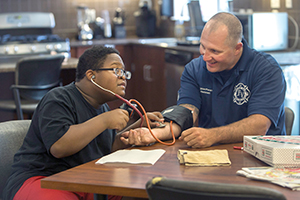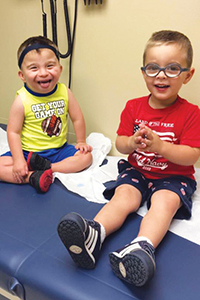By COLLEEN SCHRAPPEN
Shelby Cox, a longtime paramedic for an ambulance district in suburban St. Louis, loved her job.
But she sometimes felt uneasy answering calls for children in crisis.
For one thing, the majority of training for emergency responders is based on adult patients. But, medically speaking, children are not little adults. Ambulance calls to respond to a crisis involving a child with a serious preexisting medical condition or a condition that affects development or cognition can be anxiety-inducing for first responders. "It's terrifying, honestly," says Cox, who also works as an emergency medical service liaison for SSM Health Cardinal Glennon Children's Hospital in St. Louis. "You're walking into a scene where there's little information — a ventilator you've never seen, medical history you've never seen, medicine you've never seen."

Jason Minor, 11, gets to know Florissant, Mo., firefighter and paramedic John Herman during a firehouse visit coordinated by the Special Needs Tracking and Awareness Response System program, or STARS. Paramedics learned about Jason's health history to better care for him in the event of an emergency.
Photo by: Karen Elshout/© CHA
According to the American Academy of Pediatrics, about one of every seven children has a special health care need. Those can include cardiac issues, respiratory problems and seizures as well as autism spectrum disorders and developmental delays.
Be prepared
Cox's fellow paramedic, Patricia Casey, had noticed the same problem but had a sense of what was needed for EMS personnel to close the gaps in medical care for these pediatric patients: easier access to better information.
"I said, 'Let's have some kind of written plan and actually connect EMS workers with the children so we can gain that knowledge before an emergency takes place,'" says Casey.
In the summer of 2014, the women approached Cardinal Glennon with their idea to connect first responders with children in their district who require special care. The hospital signed on, and the Special Needs Tracking and Awareness Response System, or STARS, was born.
"Cardinal Glennon completely backed and supported us," Cox says. The hospital funds the program, and its doctors offer guidance to the first responders. "They support us because it's best for kids."
Cox and Casey began in their home district, Rock Township in Arnold, Mo. "We started small-scale. We had some families in mind and approached them," says Casey. "They jumped at it."
First responders, STARS coordinators and families come together, either at the child's home or at the ambulance district. They gather baseline information, talk about treatments, drug allergies, medications and devices. And, perhaps most importantly, they get to know one another.
"We're creating a big family within each community," Cox says. "When you meet in a non-life-threatening state, when there is an emergency, it runs so much smoother."
Each child gets a STARS identification number. When a 911 call is made, the dispatcher can reference that child's medical history and other pertinent background information and relay it to first responders. Every six months, the team revisits the care protocols with the patients and their families and updates the plan.
Confidence booster
After a successful launch in Rock Township, word of the program spread. Two years in, 56 ambulance districts in Missouri have connected to more than 300 STARS children.
Casey joined the Cardinal Glennon staff and is Missouri coordinator for the STARS program. Three others are on the outreach team, which holds about 20 trainings a month.
"I didn't think it would grow as fast as it did," says Cox. The team began reaching out into more rural parts of the state, connecting those districts to pediatric hospitals closer to home.
In July, 11-year-old Alec Ingram became STARS patient No. 1 in Franklin County, Mo., about 60 miles outside of St. Louis. Alec had been undergoing cancer treatment at Cardinal Glennon. A month after finishing chemotherapy last February, his heart failed. He spent three months in the pediatric intensive care unit and was sent home at the end of June with a left ventricular assist device to pump blood for his weakened heart.
"It's always a scary thing when you're coming home, to leave the hospital and be like, 'It's all on you now,'" says Alec's mother, Jennifer Ingram. A discharge nurse told her about STARS.

Born with complications from twin-to-twin transfusion syndrome, 3-year-old Gavin Bain, left, was the first STARS patient. He is shown here with his identical twin, Jace. The boys' mother, Nikki Bain, a paramedic in Jefferson County, Mo., is the STARS coordinator in the Rock Township Ambulance District.
Photo by: Nikki Bain
Soon after his return home, Alec was visiting the Washington Area Ambulance District, showing the paramedics his LVAD. He took a ride in an ambulance, just for fun, and had his heart monitored for a baseline measure.
"Alec told them his concerns, so he won't be scared" if something happens, Ingram says. "He knows who's coming to the house and why. It's amazing to have that support from your community."
For paramedic Matt Newman, visiting with Alec was a confidence booster. Newman and the 14 other full-time paramedics reviewed Alec's care plan with the STARS team and went over what procedures he may need in an emergency.
"I had not encountered the LVAD device in a child, only an adult," says Newman. "The (STARS) training was specific and geared toward him."
Expanding reach
There are four other ambulance districts in rural Franklin County. The STARS coordinators are working with the county to coordinate all five so that background on a child can be easily shared. A network of care across the state is the next goal for the program.
If a child is at school, or on vacation, or visiting grandma, the paramedics should be prepped with the same information regardless of whether it's the child's home district, says Casey.
"We're working on building a database to track the children formally and provide better information between districts," she says.
"Kids don't stay in one place," says Cox. "We run calls for each other, and we run into the same problem — no one knows what to do. The database will allow statewide communication. We'll be able to pull up their care plan anywhere, and we'll know what to do and how to do it."
Even as they are piloting a database for use in Missouri, the coordinators are looking outside the state. Three ambulance regions in neighboring Illinois already have implemented STARS.
"I'm hoping it will become a thing in every state," says Cox. "So that every kid has a chance."